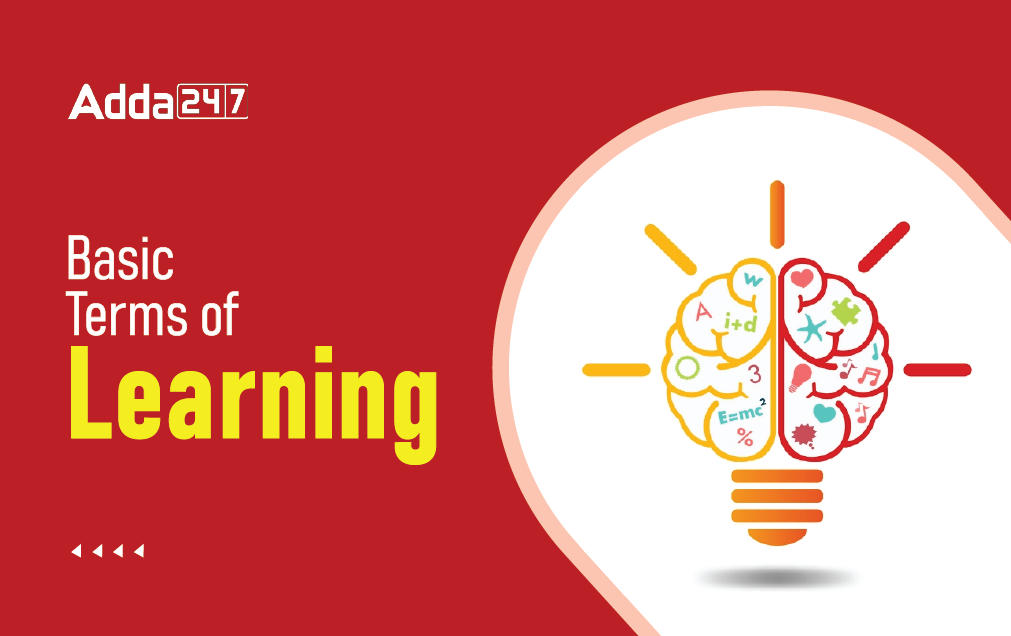Learning is a key process in human behaviour which refers to a spectrum of changes that take place as a result of one’s experience. When we started to understand learning, there comes many terms of learning. Learning, Conditioning, Shaping, Reinforcement, Transfer of learning, Punishment, Latent Learning, Cognitive Map etc are many terms which are connected to Learning. Here we are going to understand Basic terms of Learning.
Basic Terms of Learning
| S. No. | Term | Explanation |
| 1. | Learning | Learning is demonstrated by a relatively permanent change in behavior that occurs as the result of practice or experience.
|
| 2. | Classical conditioning | Classical conditioning is a learning process in which a neutral stimulus is paired with a stimulus that elicits an unconditioned response. After conditioning, the conditioned stimulus alone elicits a conditioned response. |
| 3. | Conditioned stimulus (CS) | A conditioned stimulus (CS) in classical conditioning is when an originally neutral stimulus (such as a tone) when paired with a UCS (food powder), evokes a new response (salivation). |
| 4. | Conditioned response (CR) | The conditioned response (CR) is the learned response (such as salivation in response to a tone) evoked by the CS after conditioning. |
| 5. | Extinction | Extinction is the process in which the strength of a CR decreases with repeated presentations of the CS alone (without the UCS). |
| 6. | Spontaneous recovery | Spontaneous recovery occurs after extinction and following a rest interval.
|
| 7. | Counterconditioning | Counterconditioning refers to the process of learning a new response to replace an old one.
|
| 8. | Operant conditioning | Operant conditioning changes the rate or probability of responses on the basis of the consequences that result from those responses. |
| 9. | Shaping | Shaping reinforces successive approximations of the response you want to condition. |
| 10. | Acquisition | Acquisition is the process in operant conditioning in which the rate of a reinforced response increases. |
| 11. | Extinction | Extinction refers to the decrease in the rate of a response as reinforcers are withheld. |
| 12. | Generalization | Generalization is the process in which responses conditioned in the presence of a specific stimulus appear in the presence of other, similar, stimuli. |
| 13. | Discrimination | Discrimination training occurs when responses made to appropriate stimuli are reinforced, and responses to inappropriate stimuli are ignored or extinguished. |
| 14. | Reinforcement | Reinforcement is a process that increases the rate, or probability, of the response it follows. |
| 15. | Primary reinforcer | A primary reinforcer is a stimulus (usually biologically or physiologically based) that increases the rate of a response with no previous experience or learning required. |
| 16. | Secondary reinforcer | A secondary reinforcer may be referred to as conditioned, acquired, or learned; it increases the rate of a response because of an association with other reinforcers. |
| 17. | Positive reinforcer | A positive reinforcer is a stimulus given to an organism after a response is made that increases or maintains the rate of response. |
| 18. | Negative reinforcer | A negative reinforcer is a stimulus that increases or maintains the rate of a response that precedes its removal. |
| 19. | Escape conditioning | Learning to get out of an unpleasant or painful situation once in it – is an example of negative reinforcement because the satisfying state of affairs earned by the learner is pain taken away, not a reward given. |
| 20. | Avoidance conditioning | learning not to get into an unpleasant or painful situation before it occurs – is also an example of negative reinforcement. |
| 21. | Variable-Ratio schedule (VR) | variable-ratio schedule (VR), one varies the ratio of reinforcers to responses, but maintains a given ratio as an average. Slot machines provide a good example of FR schedules in action. |
| 22. | Variable-Interval schedule (VI) | variable-interval schedule (VI) calls for a reinforcer at the first response after a time interval whose length is randomly varied. |
| 23. | Partial reinforcement effect | The partial reinforcement effect refers to the phenomenon that a behavior maintained on a partial schedule of reinforcement is more resistant to extinction that one maintained on CRF. |
| 24. | Punishment | Punishment can be an impressive modifier of behavior. |
| 25. | Positive punishment | Positive punishment involves adding an aversive consequence after an undesired behavior is emitted to decrease future responses. In positive punishment, you add an undesirable stimulus to decrease a behavior. |
| 26. | Negative punishment | Negative punishment includes taking away a certain reinforcing item after the undesired behavior happens in order to decrease future responses. In negative punishment, you remove a pleasant stimulus to decrease a behavior. For example, when a child misbehaves, a parent can take away a favorite toy. In this case, a stimulus (the toy) is removed in order to decrease the behavior. |
| 27. | Cognitive approaches | Cognitive approaches to learning accent changes that occur in an organism’s system of mental representations of itself and its world. |
| 28. | Latent learning | Latent learning is hidden learning that is not demonstrated in performance until it is reinforced. |
| 29. | Social learning theory | Social learning theory refers to the idea that learning often takes place through observation and imitation of models. |
| 30. | Vicarious reinforcement | Vicarious reinforcement leads to acquisition of new behaviors or disinhibition of behavior. |
| 31. | Vicarious punishment | Vicarious punishment leads to inhibition of behavior. |
| 32. | Cognitive map | Cognitive map or mental representation of their physical environment. |
Download Basic Terms of Learning PDF(In English)
Download Basic Terms of Learning PDF (In Hindi)




 MP TET Varg 3 Notification 2025 Out, Che...
MP TET Varg 3 Notification 2025 Out, Che...
 CG Vyapam Pre Deled Final Answer Key 202...
CG Vyapam Pre Deled Final Answer Key 202...
 CG Vyapam Pre DElEd Result 2025 Out, Dir...
CG Vyapam Pre DElEd Result 2025 Out, Dir...




